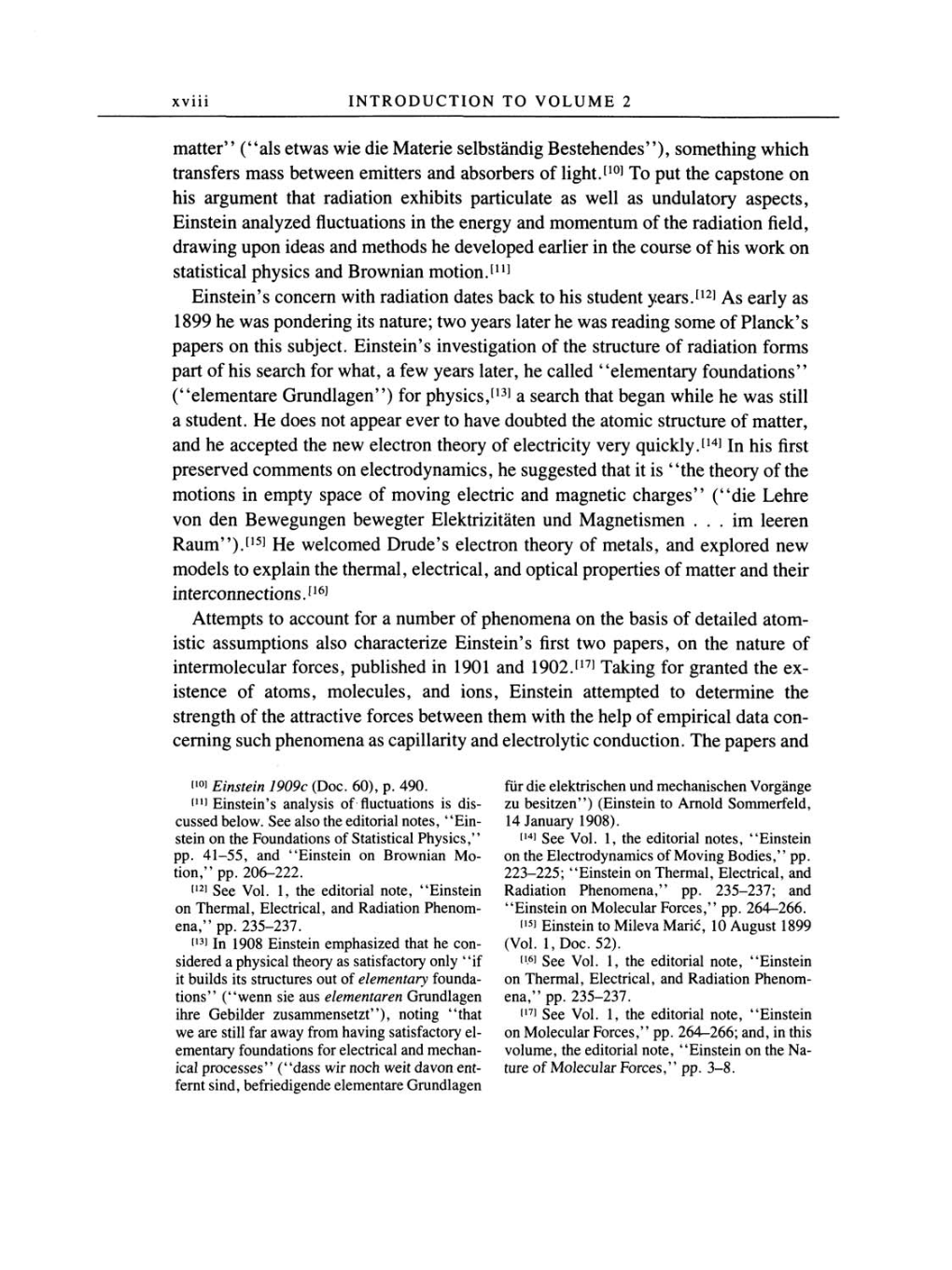xviii INTRODUCTION
TO
VOLUME
2
matter"
("als
etwas
wie die Materie
selbständig
Bestehendes"),
something
which
transfers
mass
between emitters
and
absorbers
of
light.[10]
To
put
the
capstone
on
his
argument
that radiation exhibits
particulate as
well
as
undulatory aspects,
Einstein
analyzed
fluctuations in the
energy
and momentum
of
the
radiation
field,
drawing upon
ideas and methods he
developed
earlier
in
the
course
of
his work
on
statistical
physics
and Brownian
motion.[11]
Einstein's
concern
with radiation dates back to his student
years.[12]
As
early
as
1899 he
was pondering
its
nature;
two
years
later
he
was reading
some
of Planck's
papers
on
this
subject.
Einstein's
investigation
of
the structure
of
radiation forms
part
of
his search
for
what,
a
few
years
later,
he called
"elementary
foundations"
("elementare
Grundlagen")
for
physics,[13]
a
search that
began
while he
was
still
a
student. He does
not
appear
ever
to
have doubted the atomic structure
of
matter,
and
he
accepted
the
new
electron
theory
of
electricity very
quickly.[14]
In his first
preserved
comments
on electrodynamics,
he
suggested
that it is
"the
theory
of
the
motions in
empty space
of
moving
electric and
magnetic
charges"
("die
Lehre
von
den
Bewegungen bewegter
Elektrizitäten und
Magnetismen
...
im leeren
Raum").[15]
He welcomed
Drude's
electron
theory
of
metals,
and
explored
new
models to
explain
the
thermal,
electrical,
and
optical properties
of
matter and
their
interconnections.[16]
Attempts
to account for
a
number
of
phenomena on
the basis
of
detailed atom-
istic
assumptions
also characterize
Einstein's
first two
papers, on
the nature
of
intermolecular
forces,
published
in
1901
and
1902.[17]
Taking
for
granted
the
ex-
istence of
atoms,
molecules,
and
ions,
Einstein
attempted
to
determine
the
strength
of
the attractive forces between them with the
help
of
empirical
data
con-
cerning
such
phenomena as capillarity
and
electrolytic
conduction. The
papers
and
[10]
Einstein 1909c
(Doc.
60),
p.
490.
[11]
Einstein's
analysis
of
fluctuations is dis-
cussed below. See also the editorial
notes,
"Ein-
stein
on
the Foundations
of
Statistical
Physics,"
pp.
41-55, and
"Einstein
on
Brownian
Mo-
tion,"
pp.
206-222.
[12]
See Vol.
1,
the editorial
note,
"Einstein
on
Thermal,
Electrical,
and Radiation Phenom-
ena,"
pp.
235-237.
[13]
In 1908 Einstein
emphasized
that he
con-
sidered
a physical
theory as satisfactory only
"if
it builds its structures
out
of
elementary
founda-
tions"
("wenn sie
aus
elementaren
Grundlagen
ihre Gebilder zusammensetzt"),
noting
"that
we are
still far
away
from
having
satisfactory
el-
ementary
foundations for electrical and mechan-
ical
processes"
("dass wir noch weit davon ent-
fernt
sind,
befriedigende
elementare
Grundlagen
für die elektrischen und mechanischen
Vorgänge
zu
besitzen")
(Einstein to
Arnold
Sommerfeld,
14
January
1908).
[14]
See Vol.
1,
the editorial
notes,
"Einstein
on
the
Electrodynamics
of
Moving
Bodies,"
pp.
223-225;
"Einstein
on
Thermal, Electrical,
and
Radiation Phenomena,"
pp.
235-237; and
"Einstein
on
Molecular Forces,"
pp.
264-266.
[15]
Einstein to
Mileva
Maric, 10 August
1899
(Vol.
1,
Doc.
52).
[16]
See Vol.
1,
the editorial
note,
"Einstein
on
Thermal,
Electrical,
and
Radiation Phenom-
ena,"
pp.
235-237.
[17]
See Vol.
1,
the
editorial
note,
"Einstein
on
Molecular Forces,"
pp.
264-266;
and,
in this
volume,
the editorial
note,
"Einstein
on
the Na-
ture
of Molecular
Forces,"
pp.
3-8.
